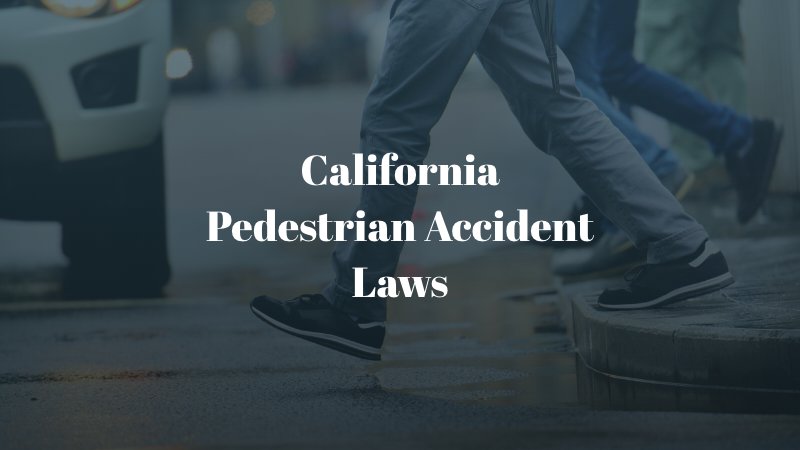California Pedestrian Accident Laws
Did you know that pedestrians have specific rights around California roadways? In an effort to protect both pedestrians and motorists, the California legislature has made pedestrian right-of-way laws fairly clear. These laws pertain to both pedestrians and motor vehicle operators. But what are the rules after an accident occurs? Our Oakland pedestrian accident lawyer will explain what you need to know about these laws.

Pedestrian Right-of-Way in California
In California, pedestrians generally have the right of way at marked crosswalks, unmarked crosswalks at intersections, and designated pedestrian areas. Vehicle drivers are required to yield to pedestrians crossing the street in these locations. According to California Vehicle Code Section 21950, drivers must exercise caution when approaching a pedestrian and stop to allow them to cross safely.
However, pedestrians are also required to exercise reasonable care for their own safety. Pedestrians should not suddenly leave a curb or other place of safety and walk into the path of a vehicle that is too close for the driver to stop in time. Additionally, pedestrians are required to obey traffic signals and use designated crosswalks when crossing roadways.
Common Causes of Pedestrian Accidents
Pedestrian accidents can occur for many reasons, often involving negligence from either the driver or the pedestrian. Some common causes include:
- Distracted driving. Many accidents happen because drivers are not paying attention to the road, whether due to texting, talking on the phone, or adjusting the car’s controls.
- Failure to yield. When drivers do not yield to pedestrians in crosswalks or at intersections, serious accidents can occur.
- Speeding. Excessive speed reduces a driver’s ability to react in time to avoid hitting a pedestrian, especially in areas with heavy foot traffic.
- Pedestrians disobeying signals. Sometimes, pedestrians fail to follow traffic signals or jaywalk, putting themselves at risk of being struck by a vehicle.
Do You Need to Report a Pedestrian Collision in California?
Yes, under California law, you must report a pedestrian accident to the authorities if it results in injury, death, or significant property damage. According to California Vehicle Code Section 20008, drivers involved in an accident must report it to the California Highway Patrol (CHP) or the local police department within 24 hours if there are any injuries. Failing to do so can result in fines and other penalties.
For minor accidents, it is still advisable to file a police report, as having an official record can be helpful when dealing with insurance claims or legal actions later on.
Determining Fault in a Pedestrian Accident
California operates under a system of comparative negligence, meaning that liability in a pedestrian accident case may be shared between both parties. For example, a pedestrian may be found partially at fault if they were jaywalking or crossing against a traffic signal when the accident occurred. However, even if the pedestrian is partly responsible, they may still recover compensation, though their award will be reduced by their percentage of fault.
How Long Do You Have to File a California Pedestrian Accident Claim?
In California, the statute of limitations for filing an Oakland personal injury lawsuit after a pedestrian accident is typically two years from the date of the accident. This means you must file a lawsuit within this time frame or risk losing the right to pursue compensation. If the accident resulted in a fatality, family members of the victim can file a wrongful death claim, also within a two-year period.
For claims involving government entities (such as if a pedestrian accident occurred due to unsafe conditions on public property), you are required to file a claim within six months from the date of the accident.
What Compensation Can Pedestrian Accident Victims Recover?
If you are injured in a pedestrian accident, you may be entitled to recover compensation for various damages, including:
- Medical expenses. This includes emergency care, hospital bills, surgeries, rehabilitation, and future medical treatment.
- Lost wages. If you are unable to work due to your injuries, you may be entitled to recover compensation for lost income.
- Pain and suffering. This includes compensation for physical pain, emotional distress, and reduced quality of life due to the accident.
- Property damage. If any personal property, such as a cellphone or other belongings, was damaged in the accident, you may be entitled to compensation for repairs or replacement.
Steps to Take After a Pedestrian Accident
Here are some key steps to follow after a pedestrian accident in California:
- Seek medical attention. Your health is the top priority. Even if you think your injuries are minor, it is important to get checked out by a doctor.
- Report the accidents. Report the accident to the police, especially if there are any injuries or significant damage.
- Gather evidence. If you are able, collect information at the scene, including the driver’s contact and insurance details, photographs of the accident scene, and contact information for any witnesses.
- Contact a pedestrian accident attorney. An Oakland accident attorney can help you understand your legal rights and options for pursuing compensation. They will also handle negotiations with insurance companies on your behalf.
Pedestrian accidents can result in serious injuries, but understanding your rights under California law can help you navigate the aftermath. If you or a loved one has been involved in a pedestrian accident, it is important to seek legal guidance as soon as possible. Milanfar Law Firm, PC is here to provide the support you need. You can reach us for a free consultation of your claim by filling out our contact form or calling us at (925) 433-6003.